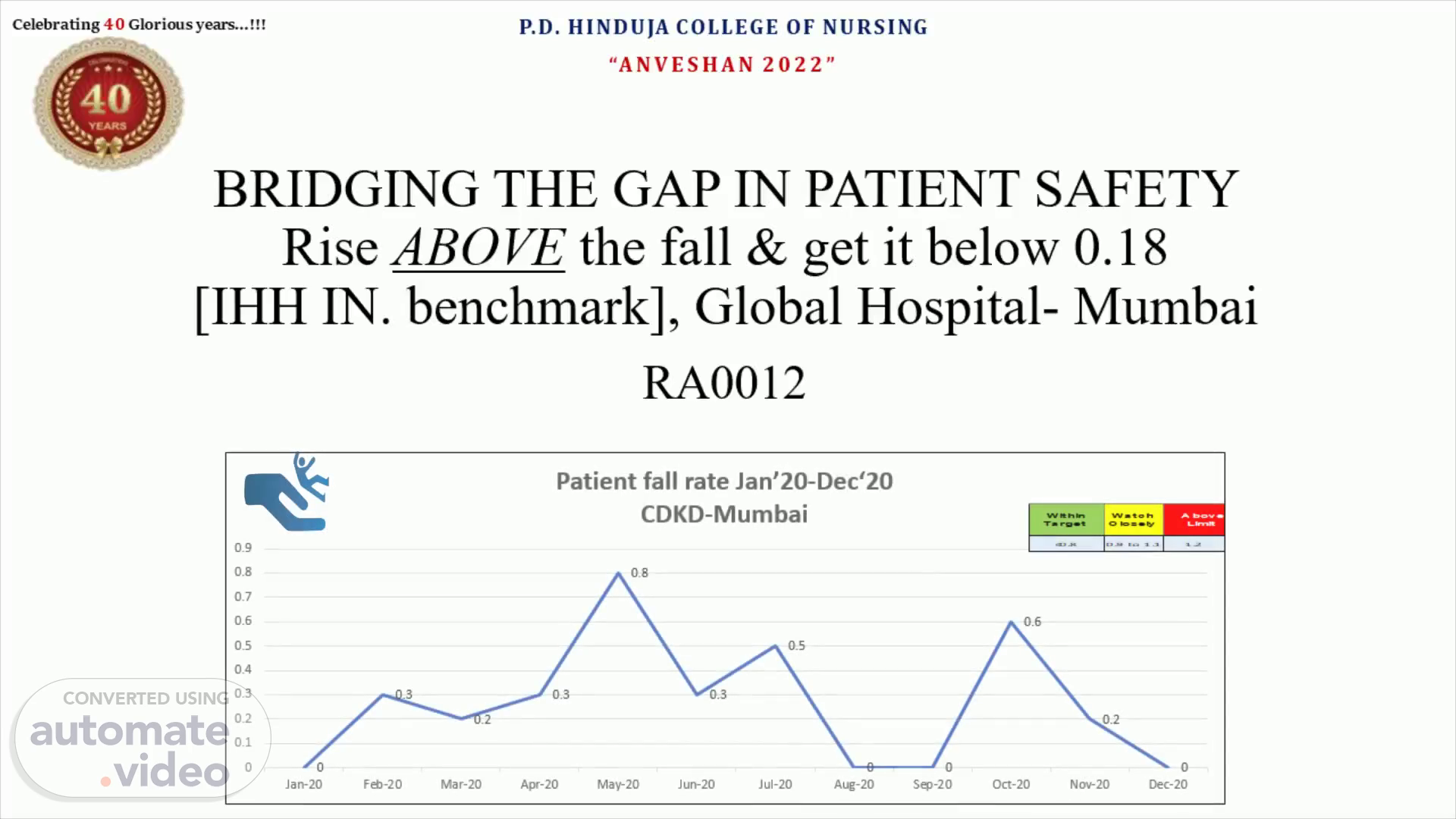
Page 1 (0s)
BRIDGING THE GAP IN PATIENT SAFETY Rise ABOVE the fall & get it below 0.18 [IHH IN . benchmark], Global Hospital- Mumbai.
Page 2 (25s)
A Study to reduce the incidents of patient fall by bridging the gap in patient safety in Global Hospitals , Mumbai..
Page 3 (51s)
OBJECTIVES To reduce the incidence of fall to below 0.18 by the following; To achieve >90% compliance to fall risk protocol; To achieve >90% awareness among nurses about fall risk protocol; To achieve 90% awareness among patients and their families. HYPOTHESES H0: - There is no significant association between incidents of patient fall and selected patient safety variables at 0.05% level of significance. H1 : - There is significant association between between incidents of patient fall and selected patient safety variables at 0.05% level of significance..
Page 4 (1m 15s)
METHODOLOGY. RESEARCH DESIGN & APPROACH A Q uantitative Research Design with a Methodological Study Approach POPULATION & SAMPLE The targeted population was all patients admitted in In Patient areas classified as Vulnerable. Convenient Sampling technique used for the study INCLUSION & EXCLUSION CRITERIA All patients admitted in the Wards All patients identified as Vulnerable as distinguished by the category All patients from Out patient departments and ICU were excluded. SAMPLE SIZE : A sample size of 250 patients falling under Vulnerable category.
Page 5 (1m 36s)
INTERVENTION V arious initiatives like: Attendant consents as an undertaking from relatives to be with the patient 24 hours; Videos for room orientation for better understanding of the room environment; Safety first board in the patient’s unit of vulnerable patient along with Orange ID band for special considerations; Covid wards- orange labelled rooms for vulnerable category which were close to Nurses station. OUTCOME ASSESSMENT/TOOLS Observational checklist to know the compliance to fall risk Protocol. Interview schedule on fall risk assessment protocol to know the knowledge of staffs. Questionnaire on fall risk assessment protocol for patients and relatives. Posters displayed to create awareness among our patients to prevent falls, Special rooms identified for vulnerable patients..
Page 6 (2m 18s)
FINDINGS. PERCENTAGE To check awareness which scale is use to fall risk assessment When do we consider patient at risk for fall Which band do you put if morse fall scale more than 25 Which of the following you explain to patient who is at risk of fall Have you taken practical demonstration of patient about side rails bed remote functioning If floor is wet does HK staff comes on time to clean 1.0 0.647058823529414 0.960784313725491 0.901960784313725 1.0 1.0.
Page 7 (2m 49s)
FINDINGS. PRE AUDIT FALL RISK PROTOCOL STAFF AWARENESS PATIENT AWARENESS 68.0 73.0 65.0 1ST POST AUDIT FALL RISK PROTOCOL STAFF AWARENESS PATIENT AWARENESS 64.0 80.0 56.0 2ND POST AUDIT FALL RISK PROTOCOL STAFF AWARENESS PATIENT AWARENESS 81.0 92.0 85.0.
Page 8 (3m 37s)
DISCUSSION & CONCLUSION. Post training it was observed that nurses are competent to vulnerable policy. They are effectively creating awareness among patients and their families. The awareness among patients and relative improved effectively and the number of falls improved drastically. To conclude, Fall measurements have been identified as important to patient outcomes by several organizations based on the fact that falls are the most frequently reported adverse patient event among adults in the inpatient setting . However , not all falls can be prevented. To sustain and maintain the compliance to protocol and to maintain fall rates within set limits, Continuous reinforcement’s, Spot trainings, Scheduled Routine round on fall risk prevention and point prevalence/monthly audits would be conducted..